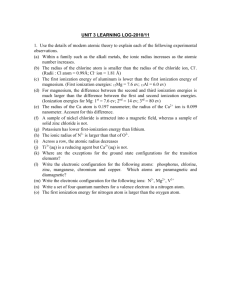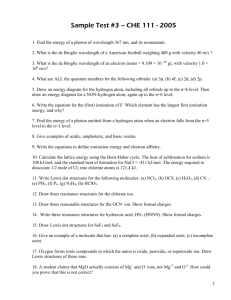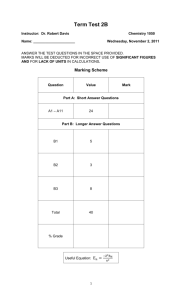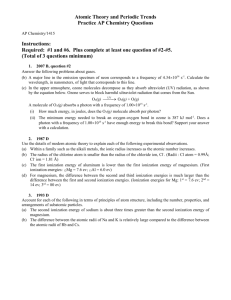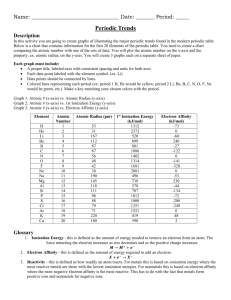Atomic Theory and Periodicity Logs
advertisement
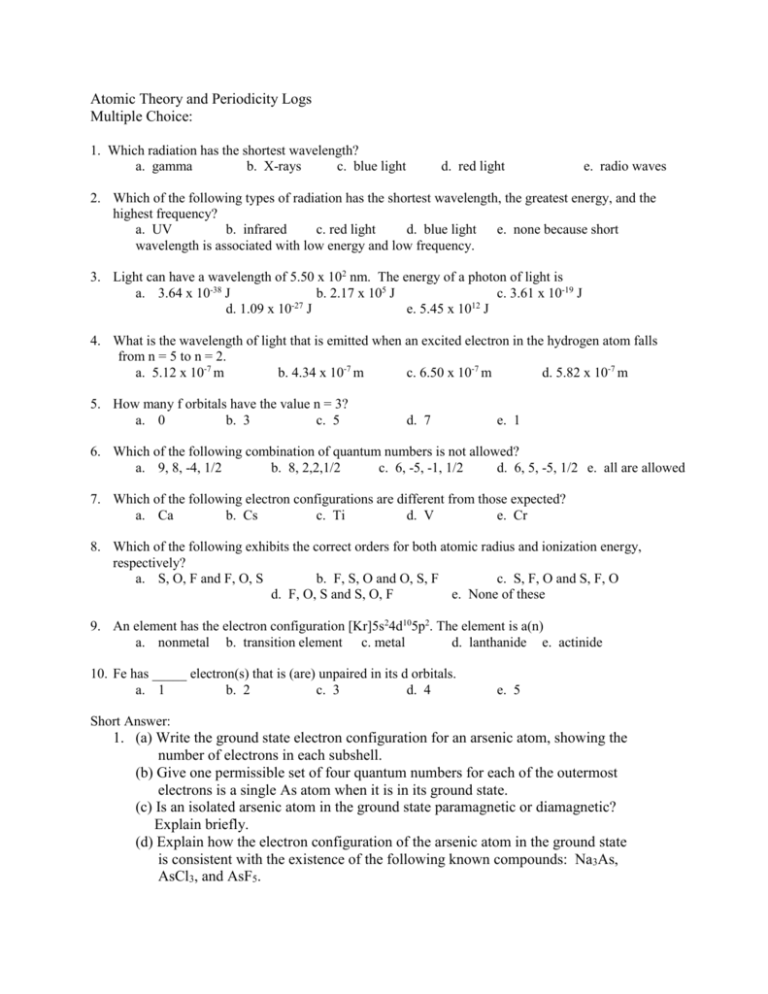
Atomic Theory and Periodicity Logs Multiple Choice: 1. Which radiation has the shortest wavelength? a. gamma b. X-rays c. blue light d. red light e. radio waves 2. Which of the following types of radiation has the shortest wavelength, the greatest energy, and the highest frequency? a. UV b. infrared c. red light d. blue light e. none because short wavelength is associated with low energy and low frequency. 3. Light can have a wavelength of 5.50 x 102 nm. The energy of a photon of light is a. 3.64 x 10-38 J b. 2.17 x 105 J c. 3.61 x 10-19 J -27 12 d. 1.09 x 10 J e. 5.45 x 10 J 4. What is the wavelength of light that is emitted when an excited electron in the hydrogen atom falls from n = 5 to n = 2. a. 5.12 x 10-7 m b. 4.34 x 10-7 m c. 6.50 x 10-7 m d. 5.82 x 10-7 m 5. How many f orbitals have the value n = 3? a. 0 b. 3 c. 5 d. 7 e. 1 6. Which of the following combination of quantum numbers is not allowed? a. 9, 8, -4, 1/2 b. 8, 2,2,1/2 c. 6, -5, -1, 1/2 d. 6, 5, -5, 1/2 e. all are allowed 7. Which of the following electron configurations are different from those expected? a. Ca b. Cs c. Ti d. V e. Cr 8. Which of the following exhibits the correct orders for both atomic radius and ionization energy, respectively? a. S, O, F and F, O, S b. F, S, O and O, S, F c. S, F, O and S, F, O d. F, O, S and S, O, F e. None of these 9. An element has the electron configuration [Kr]5s24d105p2. The element is a(n) a. nonmetal b. transition element c. metal d. lanthanide e. actinide 10. Fe has _____ electron(s) that is (are) unpaired in its d orbitals. a. 1 b. 2 c. 3 d. 4 e. 5 Short Answer: 1. (a) Write the ground state electron configuration for an arsenic atom, showing the number of electrons in each subshell. (b) Give one permissible set of four quantum numbers for each of the outermost electrons is a single As atom when it is in its ground state. (c) Is an isolated arsenic atom in the ground state paramagnetic or diamagnetic? Explain briefly. (d) Explain how the electron configuration of the arsenic atom in the ground state is consistent with the existence of the following known compounds: Na3As, AsCl3, and AsF5. 2. Use the details of the modern atomic theory to explain each of the following experimental observations. a. Within a family such as the alkali metals, the ionic radius increases as the atomic number increases. b. The radius of the chlorine atom is smaller than the radius of the choride ion, Cl-, (radii: Cl atom = 0.99 A; Cl- ion = 1.81 A) c. For magnesium, the difference between the second and third ionization energies is much larger than the difference between the first and second ionization energies. (Ionization energies for Mg: 1st= 7.6 ev, 2nd = 14 ev, 3rd = 80 ev) d. The radius of the Ca atom is 0.197 nm; the radius of the Ca2+ ion is 0.099 nm. Account for this difference. e. A sample of nickel chloride is attracted into a magnetic field, whereas a sample of solid zinc chloride is not. f. The ionic radius of N3- is larger than that of O2-. g. Ti3+(aq) is colored but Na+(aq) is not. 3. The diagram shows the first ionization energies for the elements from Li to Ne. Briefly (in one to three sentences) explain each of the following in terms of atomic structure. a. In general, there is an increase in the first ionization energy from Li to Ne. b. The first ionization energy of B is lower than that of Be. c. The first ionization energy of O is lower than that of N. d. Predict how the first ionization energy of Na compares to those of Li and of Ne. Explain. Answers to MC: a, a, c, b, a, c, e, a, c, d
